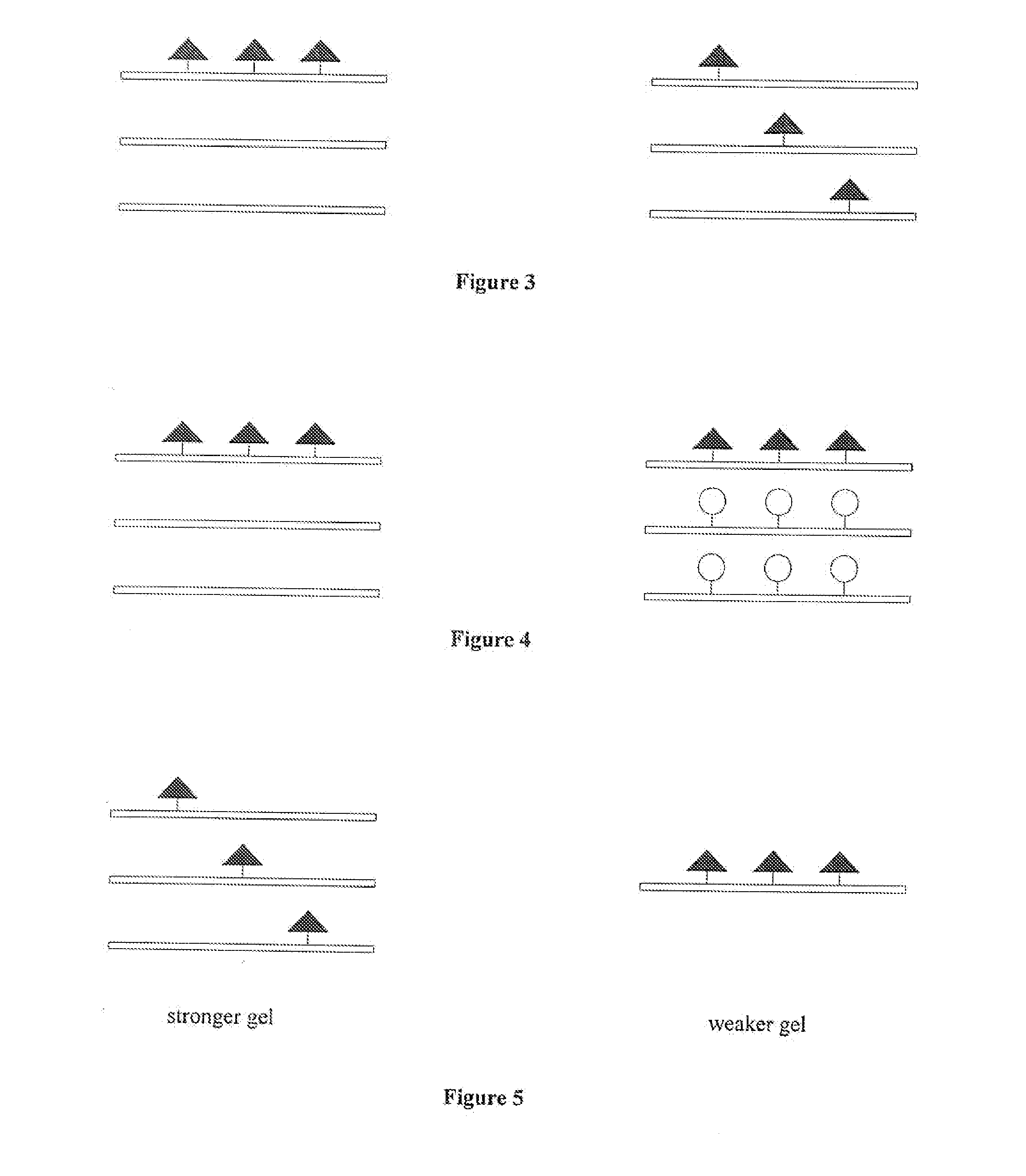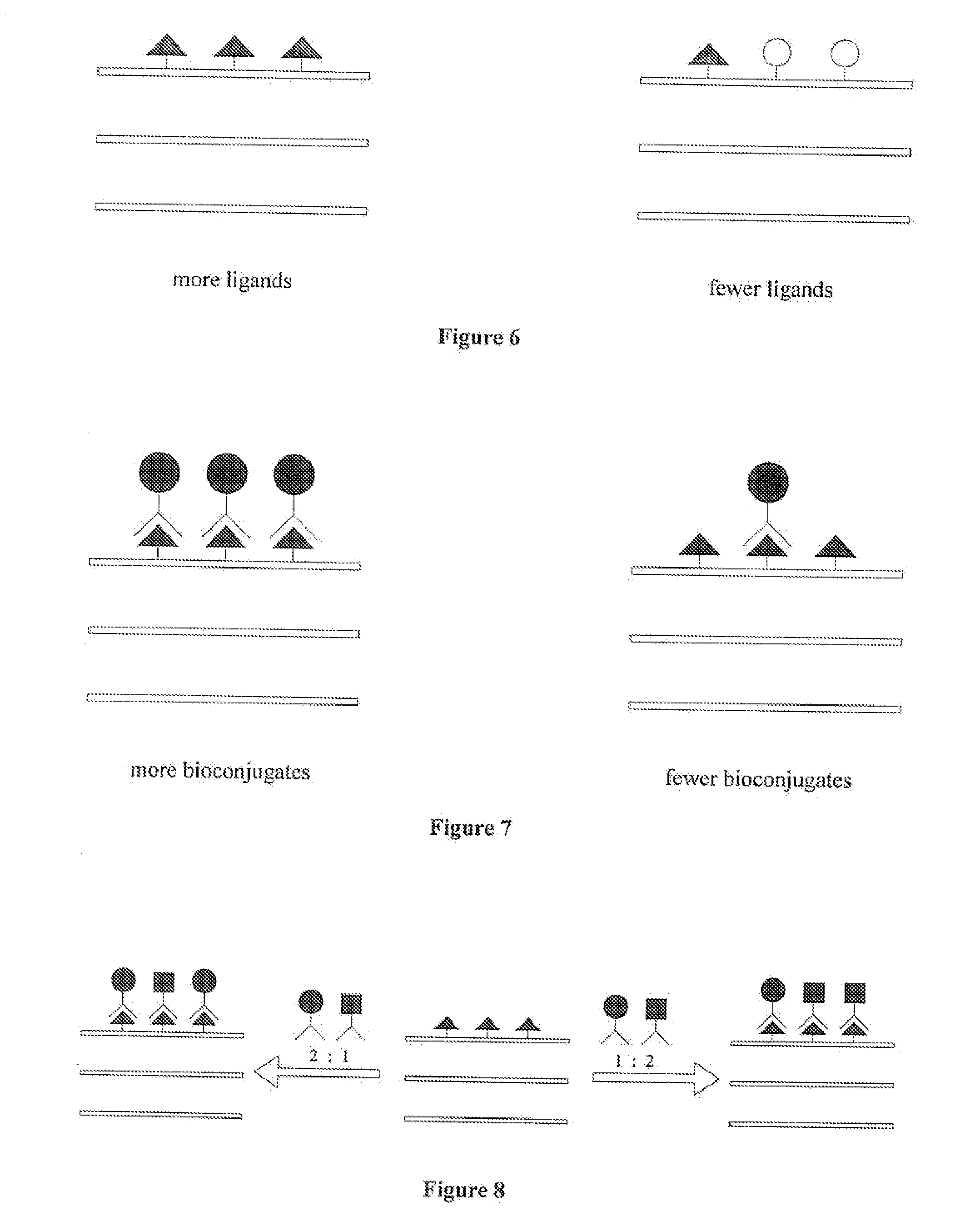Engineered Biological Matrices
a biocompatible, matrix technology, applied in the field of modified biocompatible matrices, can solve the problems of inability to achieve the desired mechanical properties, inability to achieve high cell attachment or proliferation, and difficulty in varying the concentration of active agents within the matrix, and achieve the effect of greater biomolecule mobility
- Summary
- Abstract
- Description
- Claims
- Application Information
AI Technical Summary
Benefits of technology
Problems solved by technology
Method used
Image
Examples
example 1
Preparation of Agarose Matrices with Similar Ligand Concentration and Varying Gel Strength
[0106] A series of agarose samples (A-E) were prepared with identical ligand concentration and varying gel strength. A derivatized agarose concentrate was prepared by suspending 10 g NuFix® Clyoxal Agarose with a binding capacity of 0.280 meq / g (Cambrex Bio Science) in a 400 mL aqueous solution of 2.5 mM SHA-X-hydrazide (Cambrex Bio Science) and 8 mM acetic hydrazide (Sigma-Aldrich). The 1:3.2 ratio of SHA-X-hydrazide to acetic hydrazide was assumed to be reflected in the corresponding immobilized groups. After 1 hour, the liquid was separated from the derivatized gel.
[0107] The moist, derivatized gel was then divided into 5 equal parts of equal mass and each portion suspended in 200 mL water. To each suspension was added one 6 g portion of five different agarose powders (SeaKem® Gold, SeaKem® LE, SeaKem® HGT, HSB-LV, and SeaPlaque®, all from Cambrex Bio Science). The underivatized agarose ma...
example 2
Preparation of Agarose Matrices with Varying Clustered Ligand Concentration and Similar Gel Strength
[0109] A pair of agarose samples (F and G) was prepared with varying ligand concentration and similar gel strengths. A derivatized agarose concentrate was prepared by the approach described above, but altering the ratios of the SHA-derivatized NuFix® and the SeaKem® LE to provide two levels of ligand concentration.
[0110] A derivatized agarose concentrate was prepared by suspending 165 mg NuFix® Glyoxal Agarose with a binding capacity of 0.280 meq / g (Cambrex Bio Science) in a 6.6 mL aqueous solution of 2.5 mM SHA-X-hydrazide (Cambrex Bio Science) and 8 mM acetic hydrazide (Sigma-Aldrich). The 1:3.2 ratio of SHA-X hydrazide to acetic hydrazide was assumed to be reflected in the corresponding immobilized groups. After 1 hour, the liquid was separated from the derivatized gel. The moist, derivatized gel was then divided. A major portion of the wet mass (454 mg) was suspended in 200 mL w...
example 3
Preparation of Agarose Matrices with Varying Diffuse Ligand Concentration and Similar Gel Strength
[0112] A further pair of agarose samples (H and I) was prepared with varying ligand concentration and similar gel strengths. These differed from F and G in that the ratios of the SHA-derivatized NuFix® and the SeaKem® LE Agarose was kept constant, but the ratio of SHA Hydrazide to acetic hydrazide was varied to provide two levels of ligand spacing.
[0113] To prepare sample H, a derivatized agarose concentrate was prepared by suspending 1.5 g NuFix® Glyoxal Agarose with a binding capacity of 0.280 meq / g (Cambrex Bio Science) in a 60 mL aqueous solution of 0.25 mM SHA-X-hydrazide (Cambrex Bio Science) and 10.25 mM acetic hydrazide (Sigma-Aldrich). The 1:41 ratio of SHA-X-hydrazide to acetic hydrazide was assumed to be reflected in the corresponding immobilized groups. After 1 hour, the moist, derivatized gel suspension was further diluted with 140 mL water and 4.5 g SeaKem LE agarose add...
PUM
 Login to View More
Login to View More Abstract
Description
Claims
Application Information
 Login to View More
Login to View More - R&D
- Intellectual Property
- Life Sciences
- Materials
- Tech Scout
- Unparalleled Data Quality
- Higher Quality Content
- 60% Fewer Hallucinations
Browse by: Latest US Patents, China's latest patents, Technical Efficacy Thesaurus, Application Domain, Technology Topic, Popular Technical Reports.
© 2025 PatSnap. All rights reserved.Legal|Privacy policy|Modern Slavery Act Transparency Statement|Sitemap|About US| Contact US: help@patsnap.com



